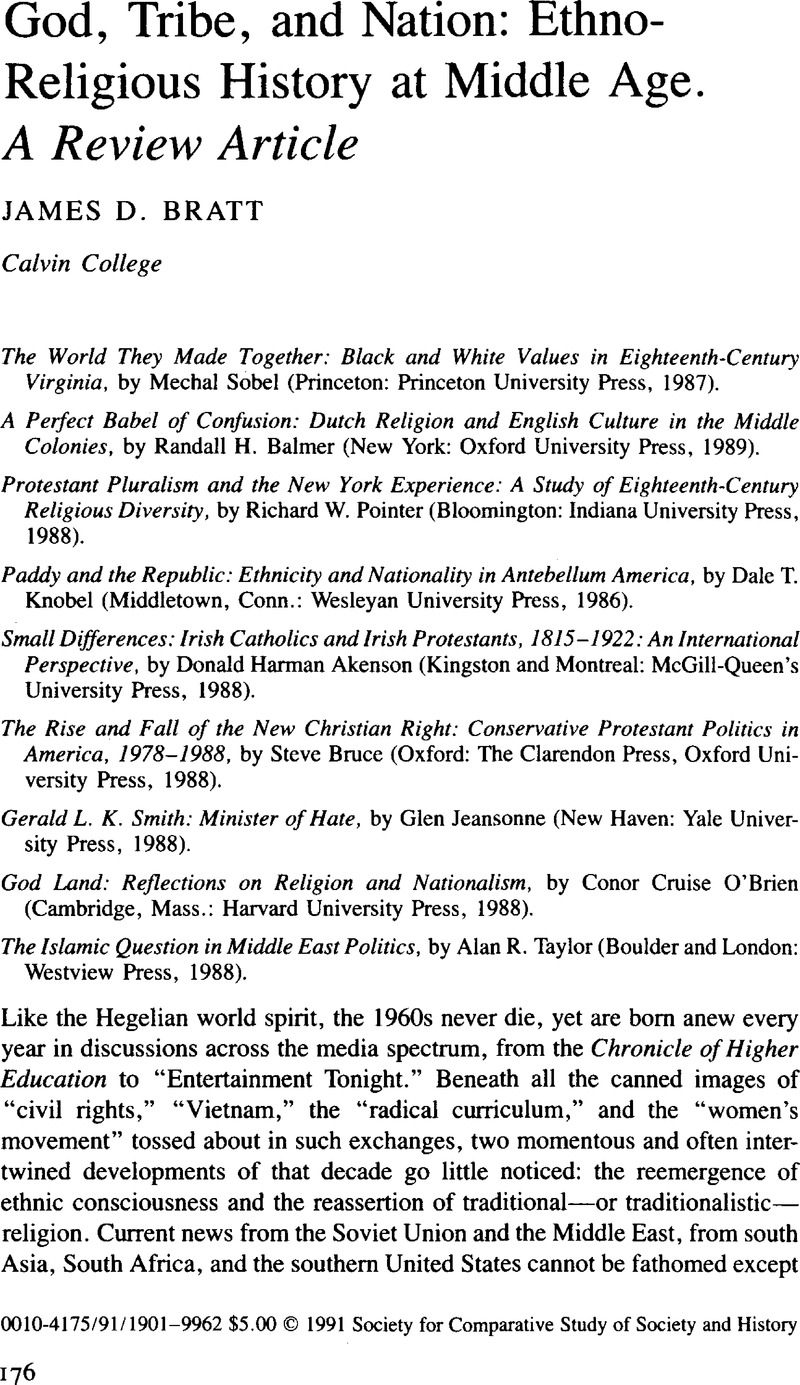Article contents
God, Tribe, and Nation: Ethno-Religious History at Middle Age. A Review Article
Published online by Cambridge University Press: 03 June 2009
Abstract

- Type
- CSSH Discussion
- Information
- Copyright
- Copyright © Society for the Comparative Study of Society and History 1991
References
1 Abramson, Harold J., Ethnic Diversity in Catholic America (New York: Wiley, 1973);Google ScholarGreeley, Andrew, Ethnicity in the United States: A Preliminary Reconnaissance (New York: Wiley, 1974);Google ScholarMarty, Martin, “Ethnicity: The Skeleton of Religion in America,” Church History, 41 (03 1972), 5–21;CrossRefGoogle ScholarNovak, Michael, The Rise of the Unmeltable Ethnics: Politics and Culture in the Seventies (New York: Macmillan, 1972);Google ScholarSmith, Timothy L., “Religion and Ethnicity in America,” American Historical Review, 83 (12 1978), 1155–85.CrossRefGoogle Scholar
2 Polenberg, Richard, One Nation Divisible: Race, Class, and Ethnicity in the United States since 1938 (New York: Viking, 1980);Google ScholarKelley, Robert M., The Cultural Pattern in American Politics, 1776–1877 (New York: Knopf, 1979);Google ScholarSollors, Werner, Beyond Ethnicity: Consent and Descent in American Culture (New York: Oxford University Press, 1986).Google Scholar
3 Elkins, Stanley M., Slavery: A Problem in American Institutional and Intellectual Life Chicago: University of Chicago Press, 1959);Google ScholarGenovese, Eugene, The World the Slaveholders Made: Two Essays in Interpretation (New York: Pantheon, 1969),Google Scholar and Roll, Jordan, Roll: The World the Slaves Made (New York: Vintage, 1974).Google Scholar
4 Mead, Sidney E., The Lively Experiment (New York: Harper and Row, 1963);Google ScholarThe Nation with the Soul of a Church (New York: Harper and Row, 1975).Google Scholar
5 Handlin, Oscar, Boston's Immigrants, 1790–1880 (Cambridge, Mass.: Harvard University Press, 1959);Google ScholarBillington, Ray, The Protestant Crusade, 1800–1860 (New York: Macmillan, 1938);Google ScholarDavis, David Brion, “Some Themes of Counter-Subversion: An Analysis of Anti-Masonic, Anti-Catholic, and Anti-Mormon Literature,” Mississippi Valley Historical Review, 47 (09 1960), 205–24.CrossRefGoogle Scholar
6 Akenson notes the work of Wittke, Carl, The Irish in America (New York: Russell and Russell, 1956);Google ScholarShannon, William, The American Irish (New York: Macmillan, 1963);Google ScholarMcCaffrey, Lawrence J., The Irish Diaspora in America (Bloomington: Indiana University Press, 1976);Google Scholar and especially Miller, Kerby A., Emigrants and Exiles: Ireland and the Irish Exodus to North America (New York: Oxford University Press, 1985).Google Scholar
7 Bruce, Steve, God Save Ulster! The Religion and Politics of Paisleyism (New York: Oxford University Press, 1986).Google Scholar
8 Particularly in Liebman, Robert C. and Wuthnow, Robert, eds., The New Christian Right: Mobilization and Legitimation (New York: Aldine, 1983);Google Scholar and in Bromley, David G. and Shupe, Anson, eds., The New Christian Politics (Mercer, Ga.: Mercer University Press, 1984).Google Scholar
9 A theory suggested by Marsden, George M., Fundamentalism and American Culture: The Shaping of Twentieth-Century Evangelicalism, 1870–1925 (New York: Oxford University Press, 1980), 204–5.Google Scholar
10 See Mathews, Donald G., Religion in the Old South (Chicago: University of Chicago Press, 1977).Google Scholar
- 2
- Cited by




